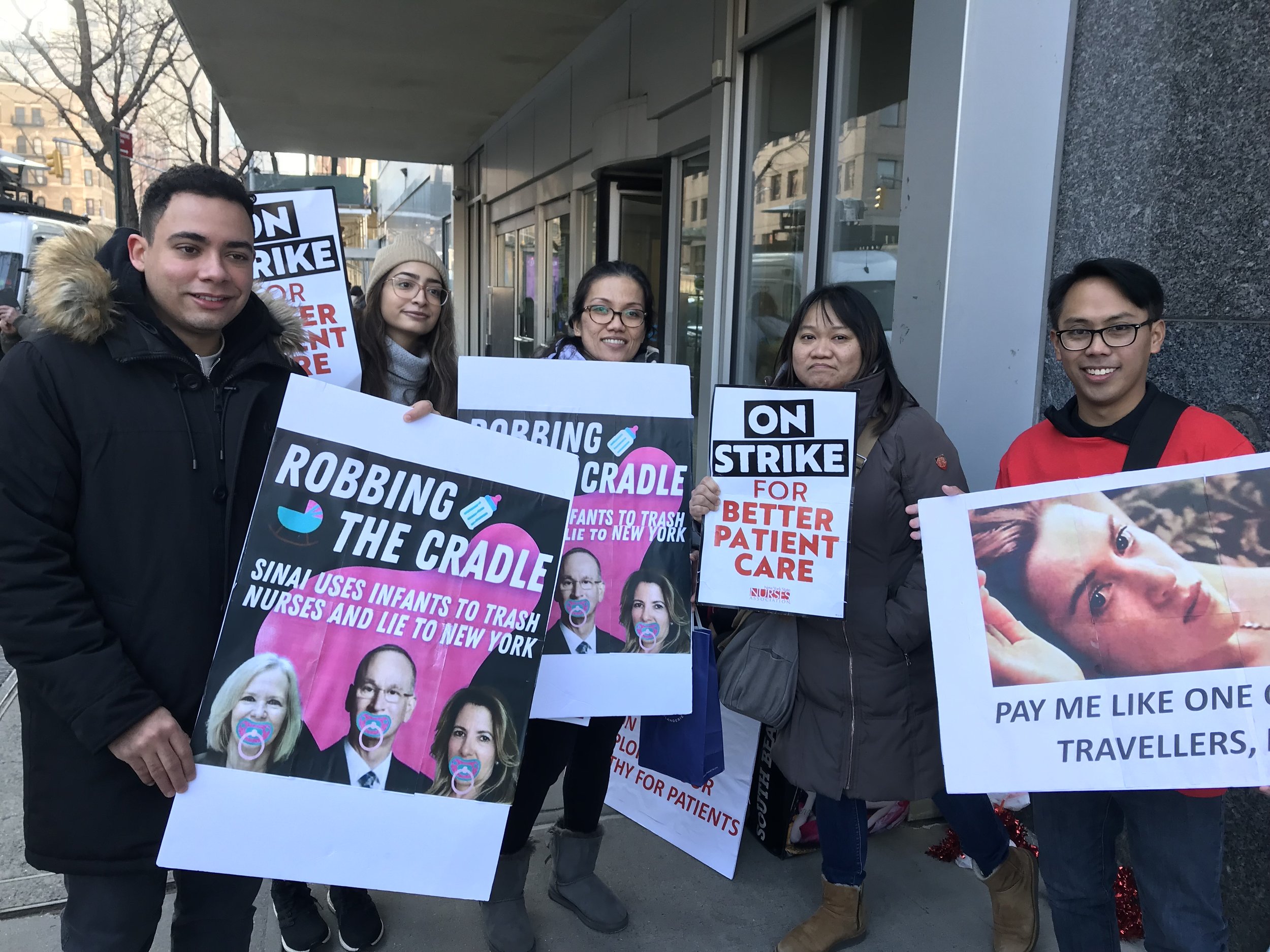‘No More Hallway Beds’: NYC Nurses End Strike For Safe Staffing Ratios
Thousands of New York City went back to work today after striking for three days at Montefiore Medical Center and Mount Sinai Hospital. Photo By Steve Wishnia
By Bob Hennelly
The tentative agreements reached between the New York State Nurses Association, Mt. Sinai and Montefiore Hospitals include a 19.2 percent pay raise over three years as well as groundbreaking and enforceable patient nursing staffing ratio requirements. The 7,000 union nurses, on strike since Monday, headed back to work today as details on the deals, that still need to be ratified, continued to emerge.
According to NYSNA President Nancy Hagans, the contract wins came without any health care coverage concessions along with several new incentives to encourage and promote nurse retention.
Hagans said the rank and file were both “exhausted” and “excited” but were gratified by the broad-based community support they had received during the strike “which raised the profile of our struggle…the same struggle nurses and patients face everywhere. A struggle for dignity and for healthcare as a human right…Yesterday on the picket line we were chanting ‘one day longer-one day stronger. Today, we are saying that when we fight, we win.”
Nurses at Wycoff Heights Hospital in Brooklyn also reached a tentative deal and withdrew their ten-day strike notice that would have been effective Jan. 17.
On Monday "we began this strike I would say for safe staffing to improve patient care. The last three days on the picket line have been historic and inspiring,” Hagan told reporters at a zoom press conference. “Our nurses are fighting for quality care for every patient regardless of your zip code, regardless of if you are rich or poor, insured, or uninsured, Black or brown or white, born in this country or abroad, young or old, or living with disability or mental illness.”
At both Mt. Sinai and Montefiore, the nurses will get 7 percent in the first year of the three-year deal, six percent in the second and 5 percent in the third and final year. “We added new experience steps to help retain nurses and increase the money on each of those steps,” Hagan said.
Mount Sinai nurses won “wall-to-wall safe staffing ratios” for all in-patient settings “with firm enforcement so that there will always be enough nurses at the bedside to provide safe patient care, not just on paper,” according to a NYNA fact sheet. Those staffing regulations take effect immediately.
At Montefiore Hospital in the Bronx management has committed to one nurse per two patients in the critical care of the Emergency Department, one to five in acute care, one to eight in sub-acute care. “We won improved staffing enforcement including new language and financial penalties paid to nurses when management fails to comply which safe staffing levels in all units,” Hagans said. “We won the preservation of the family nurse partnership program that saves at risk mothers and babies, and a commitment to re-open closed units and renovate the Emergency Room Department at Montefiore Mosses Campus to eliminate hallway beds. No more hallway beds.”
Hagans told reporters that securing the ironclad penalty provisions for the patient to nursing ratios was vital because state was not enforcing a state law passed last year that mandated them.
“Unfortunately, the Department of Health never really enforced the law or the language and as nurses we are the front line, we have to continue to care for our patients so we had to bring it to the public so everybody could know the struggle with what we go through in the hospital, and we did it in order to save our patients. At the beginning of the pandemic, we saved New York, and we want to continue to protect our patients, to care for our patients and to save our community.”
The NYSNA leader conceded that insulating nurses from cost hikes for their employer provided healthcare at the bargaining table continued to be a challenge.
“Well, that’s why we believe in Medicare for All because the employer will always have that hold on you because most of us rely on our employer for our medical benefits,” Hagens said.” We’ve been working on this for years, and we will continue to work on this so the employer will not continue to have this hold on us.”
NYSNA next battle will likely be with New York City’s Health+Hospitals, it’s 11 hospital municipal system that employs 9,000 NYSNA members.
While the precise number of nurses who died as a consequence of their occupational exposure during the COVID pandemic is not known, NYSNA has documented over 50 such fatalities. A joint Kaiser Health News and Guardian Newspaper project confirmed that in the first year of the pandemic, 3,600 nurses and healthcare workers died here in the U.S. in the first year. Throughout the pandemic, NYSNA and other healthcare unions issued prescient warnings about the potential impacts of the CDC loosening N-95 mask protocols and other public health standards.

